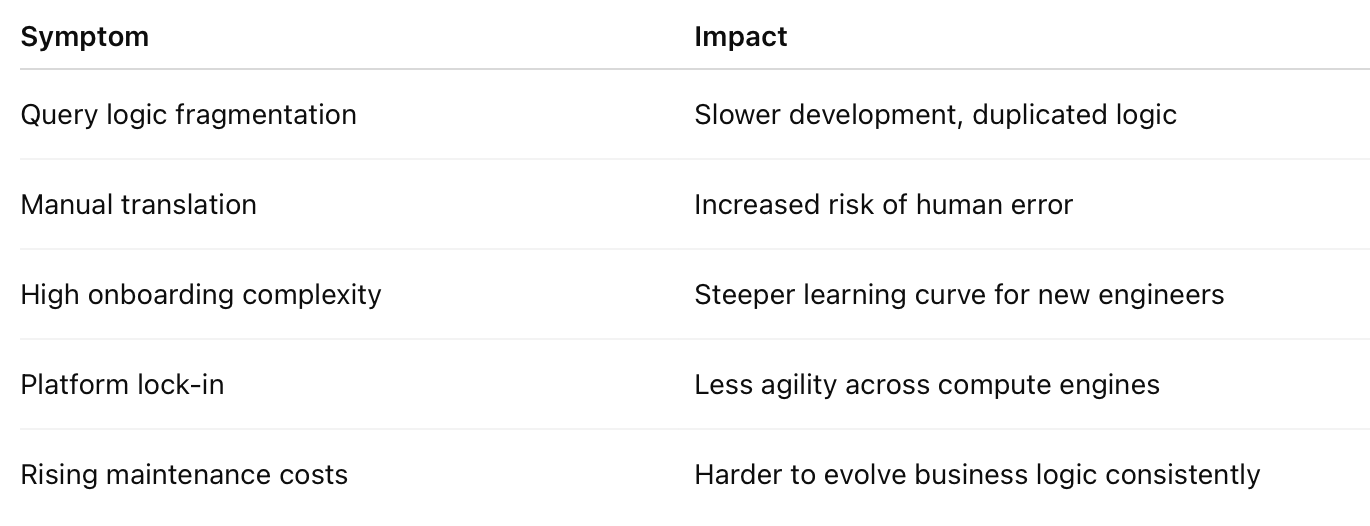Bridging SQL Dialects: How DoorDash Solved Cross-Platform Querying with Transaxle
“Every modern data stack eventually pays the price of scale: complexity.”
At DoorDash, that complexity came in the form of SQL dialects — and their solution, Transaxle, is a roadmap for anyone building at the intersection of data engineering, platform product development, and AI-driven automation.
In building SaaS products that integrate complex data workflows — across industries like fintech, logistics, and analytics — one truth has always held:
The biggest technical challenges aren’t just about performance — they’re about abstraction.
Abstracting away complexity from developers, analysts, and business teams while scaling systems behind the scenes is the real product work. What DoorDash has done with Transaxle is a shining example of this philosophy in action.
Let’s unpack it — not just to admire it, but to benchmark, steal, and adapt for your own platforms.
The Problem: Diverse SQL Engines, One Fragmented Workflow
DoorDash, like many modern enterprises, has adopted a polyglot data stack to support varying analytical needs:
Trino (Presto) for federated queries over lakehouse data
Snowflake for cloud-native warehousing and business analytics
Spark SQL for big data batch processing and ML workloads
Each engine serves its purpose — but each speaks its own dialect of SQL. And for data engineers, analysts, and platform teams, that means:
Writing the same logic multiple times, differently
Spending hours debugging dialect-specific quirks
Managing growing technical debt across tools and teams
In short: the data access layer was breaking down under the weight of its own success.
The Real Cost of SQL Fragmentation
Let’s be clear: this is not just a developer inconvenience. It’s a systemic efficiency drag.
When you're operating at DoorDash’s scale — thousands of queries, petabytes of data — these problems aren’t minor. They’re bottlenecks.
The Solution: Transaxle – DoorDash’s Unified SQL Translator
Enter Transaxle, a purpose-built internal tool that automatically translates SQL queries across DoorDash’s primary engines.
Rather than force developers to become experts in dialect conversion, Transaxle abstracts it away — turning SQL dialect translation into an internal platform service.
How Transaxle Works
Automatic SQL Translation: Transaxle translates SQL bi-directionally between Trino, Snowflake, and Spark. No manual intervention needed.
Pre-Processing Logic: Custom macros, variables, and table aliases are identified and normalized before translation. This ensures context isn’t lost in the transformation.
Post-Processing to Restore Semantics: After translation, Transaxle reinstates platform-specific references so that translated queries retain their intent, behavior, and format.
Feedback Loops for Continuous Learning: Engineers actively contribute to refining translation logic, creating a closed-loop system where quality improves with use.
Why This Matters for Any Product Organization
DoorDash didn’t build Transaxle for the sake of elegance. They built it because it unlocks real velocity.
✅ Benefits of Transaxle
Write Once, Run Anywhere. Analysts and engineers can focus on business logic, not dialect quirks.
Reduce Errors. Eliminating manual rewrites minimizes production bugs and unexpected behavior.
Boost Dev Velocity. Query once, deploy across engines. That’s days saved, every sprint.
Centralized Logic Management. Logic stored in canonical SQL becomes portable and maintainable across platforms.
Lower Onboarding Friction. New team members don’t have to memorize the intricacies of each engine.
This is exactly the kind of platform investment that multiplies team productivity — and helps your engineers stay focused on high-leverage work.
Future-Proofing with Natural Language + AI
Transaxle isn’t the endgame. It’s the infrastructure for something even bigger: natural language querying via AI.
DoorDash is experimenting with AskDataAI, a system that allows users to write plain-English prompts that get translated into optimized SQL — then routed to the right engine.
What This Unlocks
Democratized Data Access: Business users, PMs, and operations teams can self-serve insights without writing SQL.
AI-Optimized Performance: The AI layer can optimize queries for the best performance/cost profile — not just correctness.
Integrated Workflow: Combine Transaxle and AskDataAI, and you’ve created a pipeline from question to query to answer, all abstracted from platform complexity.
This is the future: AI-powered orchestration over a flexible data backend. And the foundation starts with tools like Transaxle.
🧭 Lessons for Product & Engineering Leaders
Let’s get practical. If you're leading product or engineering at a SaaS company, here are takeaways worth building toward:
Invest in Internal Dev UX. Internal tools like Transaxle aren't just nice-to-haves — they're velocity multipliers. If your teams are wasting cycles on query translation, you're leaking productivity.
Abstraction Is Product Work. A mature product org doesn’t just ship features. It abstracts complexity for its users — whether those users are internal developers or external customers.
Platform Thinking > Tool Thinking. DoorDash didn’t build a SQL helper. They built a **platform capability** that scales across teams and time.
Bridge to AI Requires Infrastructure First. Natural language querying isn’t magic. It requires standardized, high-quality translation layers like Transaxle to function correctly at scale.
Build Once, Query Anywhere
Transaxle represents what great internal platform engineering should aspire to: pragmatic abstraction that scales user impact.
If you're at a SaaS company juggling multiple SQL engines, you don't need to suffer through dialect translation, duplication, and dev toil. You can — and should — build something like this.
Or, at the very least, steal the concept.
Because in the data-driven age, your ability to ask better questions faster is your competitive edge. And systems like Transaxle ensure that edge stays sharp.
PARTNER WITH US
We’re now welcoming a limited number of sponsors who align with our SaaS-focused audience.
👉 Interested? Fill out this quick form to start the conversation.
Feel free to chat for inquires at callmariaph@gmail.com.




